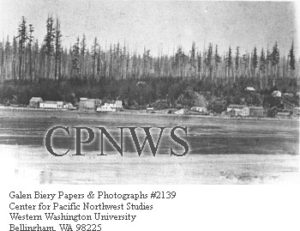
As a reuse center, we love hearing the stories of the materials that come to us, especially when the story is weaved with the history of our community. This spring our parking lot was full of old growth lumber salvaged from a house built in the 1890’s. This old growth lumber is a rare example of first growth lumber, harvested by early European settlers for construction projects in the 1880’s from a stand of trees estimated to be 500-1000 years old. Here’s the story of this remarkable timber and how it ended up with us.

In 1852 Henry Roeder and Russell V. Peabody arrived in Bellingham Bay looking for a creek with falls to power a lumber mill. Their arrival found them stepping onto the shores of an abundant forest so thick that foot travel was restricted to the beach. Soon after their arrival, loggers flooded into the area and began harvesting trees. These trees were what we now call first growth for the fact that they grew in a mature forest in which no cutting had been done by European settlers.
By the 1860’s most trees immediately adjacent to Whatcom Creek and downtown Bellingham were harvested and a booming market saw lumber shipped to California and Vancouver Island. At this point in history, most lumber mills could only receive logs from a short distance. Logs were dragged by teams of horses and oxen over skid roads – roads made of logs. By the 1880’s, however, steam engines began to power mills, and mills could move away from flowing water and closer to the source of the timber. For loggers in the area that is now Whatcom County that meant that mills began sprouting up along Lake Whatcom and the surrounding hills. Records indicate that by 1880 roughly 160 million board feet of timber was harvested each year from Washington forests.

It’s likely that when loggers in the late 1800’s were harvesting trees for construction projects, they were focused on Douglas fir. The largest coast Douglas fir trees grow to about 250ft tall and 6-12ft in diameter and were at least 500 – 1,000 years old. That means that loggers were harvesting trees that sprouted anywhere from 900AD-1400AD. For historical context, that’s before the Renaissance in Italy, before the Ming Dynasty and maybe even around the time when Iceland and Greenland were first discovered by Norsemen and Vikings. Put plainly, the trees were OLD.
It was at this time that an 8-bedroom home was built on E Street in the settlement of Whatcom, near the shores of Whatcom Creek and Bellingham Bay. The home, built in 1890 was built in the Free Classical style and much of the integrity of the original building was maintained, despite a few alterations made by various owners and residents. Knowing what we do of local logging and construction practices, and that steam engines were only just gaining traction, it’s thought that the timber used to build the house likely was harvested in the 1880’s and came from the areas surrounding Lake Whatcom.
The house at E stood for 131 years, being used as a family home, boarding home and then as office space until the spring of 2021. For 131 years the lumber from the trees harvested in 1880 held space for family gatherings and hosted important work functions, all while standing straight and strong and true.

This year our salvage crew was hired to deconstruct the E Street house. Our crew worked long hours salvaging as much as possible from the home and as a result we have thousands of board feet of nearly 1,000 year old first growth Douglas fir available for use. Two boards are especially noteworthy, stretching 37 feet. We’ve mounted one in the furniture department for new generations of loggers, builders and historians to view.
We’re so thankful to live in a community where the history and value of the material is prioritized and deconstruction crews like ours are given the opportunity to salvage the material. Thanks to the property owners, the lumber will continue to live on in the homes, workshops and buildings of the land where it was originally grown and harvested. And who knows, maybe it will continue to exist for another 1,000 years.
